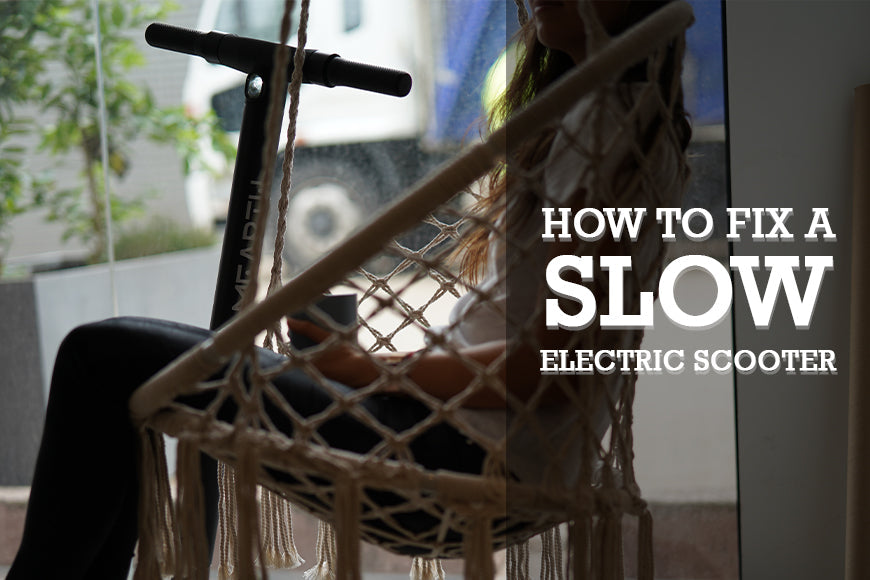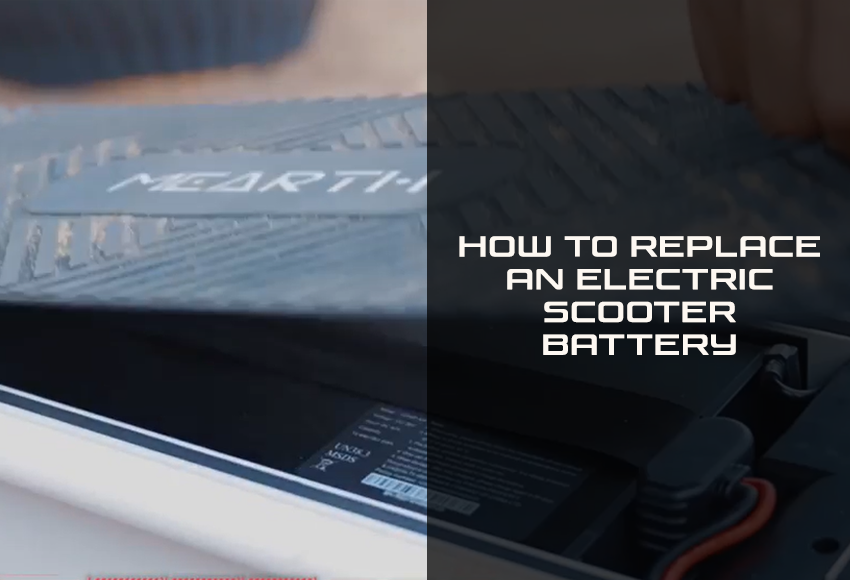
Even the best electric scooter for adults encounters issues. Electric scooters are generally low-maintenance, but owners may still encounter problems, especially if they don’t take care of their e-scooter. One issue you might experience is a slow electric scooter. Although it is uncommon, it is best to know how to fix a slow electric scooter if it happens.
If you are thinking of buying an e-scooter and considering the maintenance that comes with it, rest assured that e-scooters have a few issues to watch out for. Moreover, some issues may be fixed at home. So, before you cancel your electric scooter purchase online, check out our electric scooter repair guide on slow-moving e-scooters.
Why is My Electric Scooter Running Slow?
Here are possible causes of slow electric scooters.
If your e-scooter suddenly runs slowly, the most common cause is a defective or old battery. When a lead-acid battery contains zero to 10 per cent of charge, it will still run but with a significantly low power level.
Moreover, when a battery reaches zero per cent of state of charge, most e-scooter speed controllers include an under-voltage protection circuit, which turns off the motor to prevent further damage to the battery.
A faulty motor may also cause an e-scooter to run slowly. However, it is less likely the cause. This issue is often due to the battery, but you may look into the motor if the battery is not the problem. One problem with checking the motor is that it is difficult to diagnose, so it’s best to bring it to a professional if the battery is not the issue.
One rare but possible cause of this issue is a faulty throttle. The magnet inside the throttle may dislodge and move, making the throttle stuck to operating at slow speeds. However, this situation is rare as the throttle will not work at all if the magnet dislodges. Moreover, a throttle magnet will only dislodge if the throttle is physically damaged.
A low-pressure tyre deforms and rebounds while riding on the road. As a result, the tyres create resistance, making the e-scooter move slower. Moreover, it takes more motor and battery power to ride with low-pressure tyres, which can overwork your e-scooter.
It is unlikely for the brakes to cause a slower e-scooter, but it is also possible. If you use disc brakes, know that it needs occasional adjustment to keep the brake pads away from the rotor.
As you use your e-scooter, the brake cable stretches, and the calliper springs soften. When left unchecked, the pad can drag on the rotor, resulting in a slower-moving e-scooter.
Note that speed controllers never cause an e-scooter to run slower. If a speed controller is faulty, it will affect all the other components in your e-scooter. After all, it is the main power regulator of your e-scooter.
How to Fix a Slow Electric Scooter
Try the following methods to troubleshoot your slow e-scooter.
Find the cause of the malfunction
Start by checking the root cause of the problem. You may use the following methods to help you locate the defective component.
-
Check by sight, touch, and smell
Open your e-scooter deck and inspect the wires, connectors, and electrical components of your e-scooter. Check the condition of the battery and wires since it is the likely cause of the malfunction.
Also, smell the components, such as the motor and battery. A burnt smell means that a wire or component may have burned or melted, causing the malfunction. Replace a burnt wire, battery, or motor immediately to avoid further damage to your e-scooter components.
-
Test the charging port
If there’s no damage to the battery, check if the charging port is working. Connect the charger to the port and into the wall, and see if the charger’s indicator light turns on. If it lights up, it means that both the port and charger are working.
If your charger doesn’t have an indicator light, use a digital multimeter to check the port voltage. Connect the multimeter to the port and read the voltage. Note that the port should have the same voltage level as the battery. If the port has male terminals, be careful when testing them to avoid a short circuit.
-
Test the battery voltage
Use a multimeter to check if the cause is a low battery voltage. A working battery pack will have a higher voltage than its rated voltage, regardless of whether it has been discharged or stored. However, a battery that doesn’t reach its rated voltage level, even when fully charged, means that it is defective or worn out. Replace the battery if this is the case.
-
Inspect the motor
Check if there are any burned or melted wires, connectors or parts of the motor. If you see or smell burned plastic on the motor, it means that the coils overheated. Moreover, if the copper windings melted, it likely caused a short circuit, resulting in the motor running slowly or not running at all. Replace the motor if you encounter this.
Place your e-scooter on an elevated surface, and spin the wheel. If it doesn’t spin freely, the problem may be the brake pads touching the rotor. Remember that disc brakes need brake pad adjustment or replacement after some time. On the other hand, hydraulic disc brakes adjust on their own, while mechanical discs need no adjustments. If this is the cause, here’s how to adjust or replace electric scooter brake pads.
Check the tyre pressure by kicking or poking the tyre lightly. If it feels soft or lacks air, your tyre likely has low air pressure. Use a tyre pressure gauge for a more accurate reading. Also, check for any holes that may be causing your tyres to deflate. Learn more about electric scooter tyre pressure.
Test the throttle output voltage and signal voltage of the throttle to see if it is the cause of the malfunction. Connect a multimeter to the throttle to check the voltage. A working throttle has a 4.3V to 5V output. Otherwise, the throttle or other parts connected to the throttle (e.g. battery, power switch, fuse, wires, connectors, etc.) is faulty. If the throttle is the issue, here’s how to repair an electric scooter throttle.
Deep charge the battery
If the battery has less charge or holds less capacity, one electric scooter troubleshooting method that you can do is to deep charge it. Deep charging lead-acid batteries help equalise the cells and regain their capacity. Try charging it for 48 to 72 hours and then test it on the e-scooter.
Replace the battery or battery charger
If the battery is damaged or no longer functioning, replace the battery immediately. It’s a foolproof way on how to fix a slow electric scooter. Go to a nearby mechanic or to your retailer to replace the batteries. If you want to change it on your own, here’s a guide on how to replace an electric scooter battery.
Remember to buy original batteries made for your e-scooter from trusted retailers. Buying batteries that don’t have the same specs or brand as the original may create more issues in the future.
Replace the electric scooter motor
As mentioned, replace motors immediately if the coils overheated to prevent damaging the controller and other parts of the e-scooter. Replacing it can be tricky, depending on your e-scooter’s design. Have a mechanic replace your motors instead to keep you and your e-scooter safe.
Use the correct tyre pressure
If you have a high or low tyre pressure, adjust the tyres according to the recommended tyre pressure for your e-scooter. Use a tyre pressure gauge for a more accurate reading and adjustment. Then, test your e-scooter if it runs well. Overall, riding with the correct tyre pressure should be a staple whenever you ride your e-scooter. It is one of the secrets to maintaining your electric scooter tyres.
Bring your electric scooter to a professional
Overall, it’s best to let a professional mechanic handle your e-scooter repairs. You may inspect and troubleshoot minor problems, but a mechanic should touch on major electrical components and issues.
Fixing them on your own will be difficult and dangerous, especially if you are inexperienced with tweaking your e-scooter. Look for a local mechanic or go to your retailer’s service centre to repair your e-scooter.
Mearth electric scooter riders may bring or ship their e-scooter for repairs in our Sydney office. Request a repair online first, so our team can help with your schedule and concerns.
Check out more electric scooter repair guides on Mearth’s blog page.




Leave a comment
This site is protected by hCaptcha and the hCaptcha Privacy Policy and Terms of Service apply.